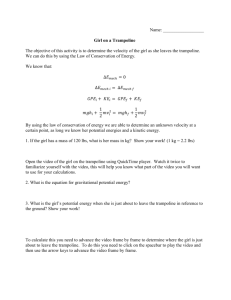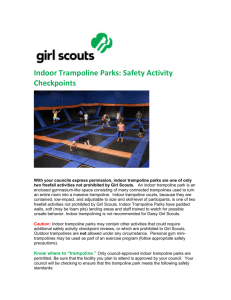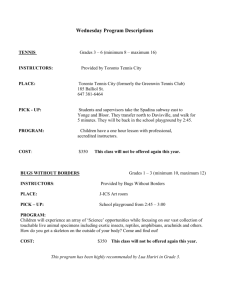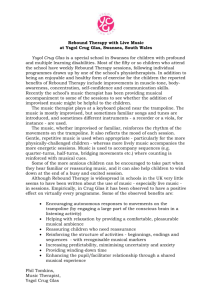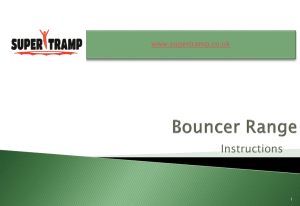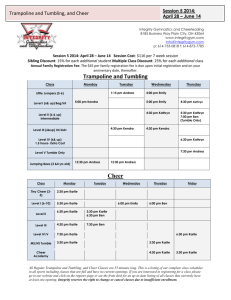Home Trampolining Safety Course
advertisement
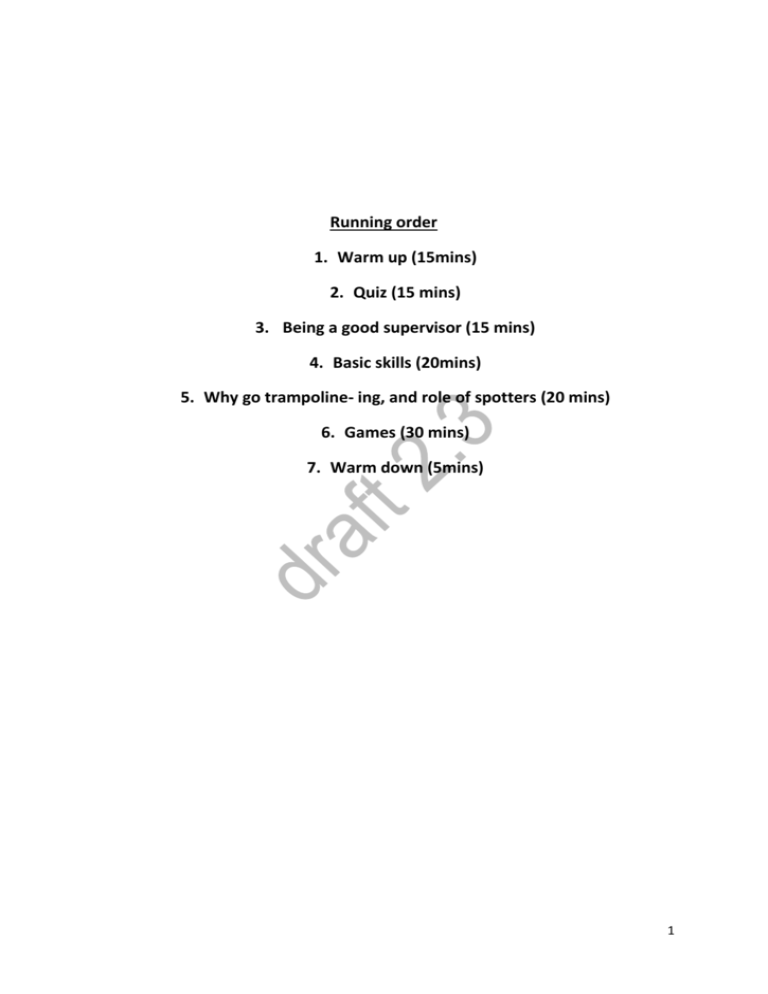
Running order 1. Warm up (15mins) 2. Quiz (15 mins) 3. Being a good supervisor (15 mins) 4. Basic skills (20mins) 5. Why go trampoline- ing, and role of spotters (20 mins) 6. Games (30 mins) 7. Warm down (5mins) 1 Home Trampoline Course. Introduction NHS Bristol estimates that every year around 1,500 children in England have to be admitted to a hospital bed as a result of a serious injury from trampolining at home and that 18,000 children have to attend emergency departments with sprains, broken bones, cuts and lacerations. Thankfully, deaths and paralysis are rare, but do regularly occur. Using a trampoline is fun. Lots of children want to use trampolines and we want to help people enjoy trampolines by reducing the chances of serious injury, which is not fun. This course is designed to help families get the most from their garden trampoline, and most importantly, helps children have the most fun being active, by reducing the chances of getting hurt. Learning new games, skills and a basic understanding of the sport of trampolining, will help individuals, families and groups of children enjoy the activity and reduce hazards at the same time. Only trained and qualified trampoline instructors should deliver this course. It is not intended for children less than six years of age. The course has been produced with an awareness of the British Gymnastics Code of Practice Key Safety messages. But the intention is that messages and skills learnt on the course are taken away, and used to keep children safe at home, as opposed to at and during trampoline courses that are led by qualified instructors. Trained trampoline instructors will want to change the course to suit their own way of teaching, and the group of people they are working with. Of course it is fine to do this. CONTENTS 1) Warm up (10 mins) 2) Quiz (10 mins) 3) Why go trampolining? And the benefits of being injury free (10mins) 4) Key messages (10 mins) 5) Role of spotters (10 mins) 6) Being a good supervisor (15 mins) 7) Basic moves (20 mins) 8) Games to play with your friends (20 mins) 9) Videos 10) More advanced combinations 2 1. Quiz We recommend that instructors organise a ‘quiz’ style session with the whole group or small group working together. The purpose of the quiz is to talk to the group in a semi-structured way about trampolines and the safety issues inherent in their use and give the instructor a chance to talk about the sport of trampolining and trampoline use in back gardens. You may need to pick and choose the questions depending on the group. 1. Trampolines were invented to help astronaughts on the space programme develop the skills the need for working in zero gravity. True/ False 2. Trampolines used in the Olympics are specially designed. True/ False 3. In the 1950s, American doctors called for home trampolines to be banned because of the number of injuries they were causing. True/ False 4. Jumping in the middle of the trampoline gives you better balance and control. True/ False 5. It’s safe to try more complicated moves if you have netting around the trampoline. True/ False 6. It’s safe to have more than one person on the trampoline if you have netting. True/ False 7. The bigger the trampoline the more people who can jump on it together. True/ False 8. Young children should use small trampolines until their co-ordination and physical strength are well-enough developed. True/ False 9. If I learn to do clever tricks at a trampoline class I should practise them at home. True/ False 10. Jumping off is safe if there is a mat to jump onto. True/ False 11. Trampolines should be stored inside during the winter and bad weather, adults should always check that the Trampoline is safe before it is used. True/ False 12. Most trampolinists get injured when they fall off the trampoline and hit the ground. True/ False 13. 14. Trampoline can help improve the strength of your bones – True/false If an adult is nearby they can help prevent injuries. True/ False 15 – Is trampolining fun? Yes 16 - Are injuries fun No! This session will help us get the best of both worlds. 3 Answers 1 – Trampolines were invented to help astronaughts on the space programme develop the skills the need for working in zero gravity. False. They were invented around 1930’s and started being manufactured in 1942. But they were used extensively during World War Two to train pilots to reduce fear of falling and help with orientation when in upside down in the plane. NASA did use them during the space programmes of the 1960s and 1970s for similar reasons. 2 – Trampolines used in the Olympics are specially designed. True. The activities we see on television are only achievable after years of specific training and never on garden trampolines. Safety Platforms The official trampoline for the Olympics must have shock-absorbent safety platforms, commonly referred to as end decks. This includes a large, thick mat that sits at either end of the trampoline. This mat offers a cushion in case a gymnast falls from the trampoline. The framework for the safety platform must be attached firmly to the ends of the trampoline. Padding Official competition trampolines used in the Olympics and other events must feature safety padding. This shock-absorbent padding covers the trampoline's spring and frames. Requirements also call for padding to be fixed firmly to the frame, but the padding must not hinder the normal action of the bed or springs. Read more: http://www.livestrong.com/article/410799-what-is-the-official-trampoline-of-theolympics/#ixzz1oQwSBXzI 3 – In the 1950s, American doctors called for home trampolines to be banned because of the number of injuries they were causing. True. As sales of trampolines for use at home rose, so to did the numbers of serious injuries – they were described as an ‘epidemic’. These serious injuries included entirely preventable fatalities and paralysis from head, neck and spinal injuries. 4 - Jumping in the middle of the trampoline gives you better balance and control. True – it is harder to control jumps from closer to the edges. 5 – It is safe to try more complicated moves if you have netting around the trampoline. False – Netting may stop you falling off, but you can still land badly on the bed of the trampoline and hurt yourself. 6 - It’s safe to have more than one person on the trampoline if you have netting. False - Having more than one person on a trampoline is the biggest risk factor for serious injury. Netting may stop you falling off, but when more than one person goes on the trampoline they may collide with each other and get hurt. The smallest person is likely to get hurt the most. 4 7 - The bigger the trampoline the more people who can jump on it together. False – The extra space doesn’t help, you are still likely to bang into each other. Other people on the trampoline won’t help by stopping you falling over. 8 - Young children should use small trampolines until their co-ordination and physical strength are well-enough developed. True/ False True – The Royal Society for the Prevention of Accidents recommends that Children under 6 should only use a trampoline designed for their age (less than 50cms in size). 9 - If I learn to do clever tricks at a trampoline class I should practise them at home. False – Trampolines at sports centres are different to home trampolines and help you to do more complicated tricks, if you are being supervised by a qualified coach they will be teaching you how to do the skill properly and will be there to stop you being hurt if the move goes wrong. 10 - Jumping off is safe if there is a mat to jump onto. False – Always climb down, people get hurt jumping off trampolines. 11 – Trampolines should be stored inside during the winter and bad weather, adults should always check that the Trampoline is safe before it is used. True – Bad weather can cause the trampoline to rust and damage the mats and netting. Always give the trampoline a quick once over before it is used in case something has happen to it, an object fallen on it, something is faulty/ worn. If it is, don’t let the trampoline be used until it is fixed. 12 - Most trampolinists get injured when they fall off the trampoline and hit the ground. False – Most injuries occur on the mat of the trampoline from bad landings or from colliding with someone or something else. This surprises most people – the most obvious hazard with trampolining (hitting the ground) is not the biggest one (hitting someone or something else on the mat). 13- Trampoline can help improve the strength of your bones – True But you need to do a lot of it if it is to have a significant effect. 14- If an adult is nearby they can help prevent injuries. Both true and false: they can help prevent dangerous behaviour (like allowing more than one person to use the trampoline at once) but on the mat, injuries happen too quickly for anyone to stop them. Spotters are really important people! Last question 15 – Is trampolining fun? Yes! 16 - Are injuries fun No! This session will help us get the best of both worlds. 5 2. Why go trampolining? And the benefits of being injury free (10mins) 1) Ask if any child in the group has been injured before – any broken bones? What was it like? Did they enjoy it? Would they want it to happen again? Get the children to tell their storey, especially if it features a trampoline. 2) Ask the group to call out the benefits. Why go trampolining? (You may want to split the group in half – one half calls out the benefits the other half negates them, saying why you don’t get the benefit if you get injured). Benefits But if you get injured Its fun! It’s not fun at all. It hurts. You are out in the open air You are in hospital Make friends Cant see your friends as often All my friends go trampolining Cant see your friends as often Gives you something to do Lying down with a broken leg is very very boring! Its cool Injuries can be prevented. Dummies get injured. Trampolining is a low impact workout Unless you fall or get hurt Bouncing on a trampoline is a great cardio workout But if you get injured you cant exercise Exercise makes your bones stronger Pain may put you off activities in the future. It has benefits to the Lymphatic System and Detoxification You cant get these benefits. Helps Toning and Trimming Cant exercise – loose tone, get unfit Increases Mental Health Hospitals are stressful and boring Improves Motor skills and Co-ordination Some serious injuries mean you cant move at all anymore Improves Metabolic Rate Not if you are lying down recovering End with “We can reduce the chances of injuries occurring, or we can do things that make injuries almost certain to occur”. 6 3 – What do other people do wrong? Get the group to think about what people might go wrong. Write feedback on flipchart. If there is time, you might like to consider which hazards are predictable / preventable / avoidable. Trampoline: Falling off the trampoline onto the ground Landing badly on the trampoline Falling through springs Falling on springs or frame without pads Broken/ damaged springs Worn mat, holes, etc Wet mat Rust / weather damaged Trampoline Not preventable ? Not preventable ? Preventable Preventable Preventable Preventable Preventable Preventable People: More than one – collisions More than one – kipping Irresponsible people drinking alcohol Attempting dangerous skills Going under the Trampoline Doing too much too soon Preventable Preventable Preventable Preventable Preventable Preventable Other: Clothing Shoes Jewellery, watches Close to walls, trees fences, clotheslines Jumping off Jumping onto the trampoline from a higher surface Being too young to use the trampoline Other equipment/ objects Preventable Preventable Preventable Preventable Preventable Preventable Preventable Preventable Not all injuries can be prevented, but the risks can be reduced. Some people have more injuries than others. You could show the films here to illustrate some of these points. 7 SAFETY STICKERS Your trampoline probably came with a sticker like these attached. Note to instructor: Some of the film clips will illustrate why these messages are attached to the trampoline. Without an internet link and a projector, discussion of injuries you have see or heard about will need to suffice. 8 4. Role of Spotters All instructors know that the role of spotters is important in helping keep the trampolinist safer. This section is intended to give spotters ‘status’ and a defined role, so that they stay focussed on the person using the trampoline ready to push them back towards the centre of the mat if they get too close to the edge. The main audience for the session are the parents, who need to be able to keep a group of children occupied and happy while only one person is on the trampoline at a time. Possible roles for spotters Parents can ask: Who wants to be the: 1) Style Judge? (Awards marks for completing moves in line with guidelines under 6 Foundation skills) 2) Height checker? (Counts bounces between certain heights) 3) Bounce Counter? (Counts continuous bounces) 4) Equipment monitor? 5) ? Create a role for each spotter in line with the title. Emphasise the importance of moving the trampolinist towards the centre of the mat and away from the springs. 9 5 – Foundation Skills: Give everybody the opportunity to do the following – both parents and children As a trained instructor, this is your forte, so run this session as you normally would with a group of complete beginners. Include: Jumping Stopping Jumping using arms Tuck jump Straddle jump Pike jump Half twist jump Full twist jump Seat landings Hands & knees 1. Getting onto and off of the trampoline 2. Role of the spotters 3. Warming Up and 4. Foundation skills Make sure you can master all of the below before you add them into games. Learning the moves is part of the fun. Remember home trampolines are for fun basic trampolining, anything more complicated should be learnt at a trampoline class and only practised under the supervision of a qualified coach. Jumping – try to stay in the centre on the same spot. Look at a point on the edge of trampoline and look at this all the time (don’t look around or at other people as this is distracting and can be dangerous). Stay in the middle! Stopping – both feet at the same time, gently bend knees & keep legs strong to absorb the bounce from the trampoline. Jumping using arms – arms go up the front to straight up by your ears reaching to the sky & then down by the sides – this helps you balance and keep control. Tuck jump – lift knees up in front & touch hands just below knees. Straddle jump – lift straight legs up in front but apart; touch hands close to your ankles. Keep head up! Pike jump – lift straight legs up in front but together; touch hands close to your ankles. Keep head up! Half twist jump – practise this on the ground first. Jump & take arms up the side; as you twist look for a spot to look at before you land. Be very good at this before doing it on the trampoline as if you fling your arms around you can throw yourself across the trampoline. Don’t carry on jumping until you are really good at this, the next jump could throw you off the side. 10 Full twist jump – once you are really good at a half twist jump, you can try to twist a little bit further by lifting your arms up a little quicker, with a bit of practise you will go all the way round. Again be careful about using your arms, keeping balance, staying in the same spot & looking for a spot on the edge of the trampoline to look at before you land. Don’t carry on jumping until you are really good at this, the next jump could throw you off the side. Seat drop – sit down with your legs and feet together. Hands are placed just behind the back so you are leaning back a bit but a bit wider than your body, fingers MUST face forwards (facing backwards can sprain your wrist), lift chest up and keep your stomach strong rather than slouching. Push your hands to bounce you up & down so that you get used to bouncing in this position, as you bounce higher you can try to stand up by pushing hard with your hands & swinging them forwards and up, this will take a few attempts to get. From standing, push your feet and legs forwards and land in the seat drop position. As you get better you will be able to go from standing to sitting down to standing up. Hands & knees – start kneeling, with your bottom up high in the air and arms straight, gently push the trampoline with both hands and knees at the same time, so both land and are in the air at the same time. You don’t want to be see-sawing from one to the other. Don’t jump too high. 11 6. Make these children safer Here are some things to think about when supervising children using a trampoline. In the picture below, some things are being done well, but the risk of injuries to the children can still be substantially reduced. Can you see how? See overleaf for a guide. How many children? What is the trampoline near to? Are the children old enough? What else (apart from the children) is on the mat? Are pads and nets fitted? What surface is the trampoline placed on? Who is supervising the children? How do the children get on and off the trampoline? 12 Not all injuries can be prevented, but risks can be substantially reduced by taking some simple steps. Suitability for age: Children under 6 should only use a trampoline designed for their age (less than 50cms in size). One at a time: Most injuries occur when more than one person is on the trampoline at one time. The child on the left, appearing younger and lighter, is at greatest risk. One at a time is much less risky. Situation: Is the trampoline too near to these trees or other hazards like fences, bins or washing lines? Pads and nets: The springs and frame have pads on - this is good. Clear mat: The mat is clear of toys and pets which is good . Nets should be fitted. 70% of injuries occur on the mat, not from hitting the ground, so nets can only prevent a small proportion of injuries. Thinking about ‘clear mat’, ‘one at a time’, and ‘suitability for age’ will help reduce risk of onmat injuries. Supervision: Is a trained supervisor present to stop jumping off the trampoline and other dangerous behaviour (like having more than one person on the mat at once)? Supervisors who have been drinking alcohol can make things more dangerous for children, increasing the chances of them getting injured. Landing on other people or objects causes bad landings that may lead to ligament damage and other injuries. Getting on and off: Ladders should be removed to stop young children getting onto the trampoline when no adults are around. Bouncing off the trampoline is very hazardous indeed. Children should climb down. Base: A grass surface is usually softer than concrete or decking. It lets you bury the legs of the trampoline to stop it tipping over and reduce the height of any falls to the ground. Keep the mat level with the ground, and allow enough space under the mat. 13 6. Games to play with others Having more than one person on the trampoline is the biggest single risk factor for serious injury. The aim of the games is to keep friends involved and having fun, without the need for more than one person to get on the trampoline at the same time. Adults make good referees! The games are simple but fun; they are about having fun together not about showing who’s best. Do not play games that involve more than one person on a trampoline at once as this is dangerous, and also do not play games that involves balls or other objects as these can be distracting and cause people to fall, especially do not throw things at people on the trampoline. Remember to give the spotters roles. Add-on One person does a move, the next person gets on & does the first person’s move & then a move of their own, the next person does the first two moves and then a move of their own. It’s OK to repeat moves, but no more than three times in a row. Keep on going until the chain is broken – a move goes wrong, can’t remember the sequence, etc. The game can either stop when one player is out or if it’s a bigger group, the players that become out can become the judges for those still left playing. Remember only one person at a time & don’t make up moves. Simon Says Person not jumping gives instructions to the person on the trampoline, eg ’Simon Says jump up & down 3 times’, ‘Simon Says do a tuck jump’, ‘Simon says do a straddle, then a pike jump’, ‘pike jump’. Pick the moves from the list in 5 above. If they do a wrong move, or do the move not beginning with “Simon says…” then they swap over. Keep the moves safe & within the capability of the player, to make it more complicated just ask them to do more things in a row that they have to remember to do in the correct order. Copy Cat The first person does a move & then one at a time, each player attempts this move, until you get back to the beginning, the second player then does a move and each player attempts this move, until you get back to the beginning. If someone doesn’t do the move properly then they get given the letter C from ‘CAT’, play continues until one player has been given all the letters: C,A,T. Ten in a row One at a time, start off with doing one seat bounce, then two in a row, then three in a row, see who can do the most, the challenge is ten in a row. Too easy? Substitute straightforward seat bounces with seat to shape. Ten in a row standing up Same as Ten in a Row but stand up in between each seat bounce. 14 Appendix 1 - Videos Download these videos and show them (if you can) to people present. Discuss what has caused the injuries and how they could have been prevented. http://www.youtube.com/watch?v=cypqTTbtvOk Looks innocuous enough, but the young man nearly breaks his neck from summersaulting without adequate training in technique. He is not badly hurt. 27 seconds http://www.youtube.com/watch?v=sjuCYUbIMSo&feature=results_main&playnext=1&list=PL005E3 F49AD7204E6 Jumping from height. Looks painful. 16 seconds of idiocy! http://www.youtube.com/watch?v=zAleEq64Hj0 A young girl talking about her injuries 2.13 http://www.youtube.com/watch?v=eDeQb1m2moQ It’s difficult to control landings when jumping from the trampoline. Poor siteing of the trampoline, no covers to the springs. 12 s http://www.youtube.com/watch?v=nje0dMJQRFE Two people on a trampoline at the same time, foot caught in springs (no mats). Child sustains a broken ankle. 42 seconds http://www.youtube.com/watch?v=DtaG-mFXykU Unspectacular fall from trampoline following bad landing. Nets would have prevented it. Not doing summersaults would have prevented it. 46 s. http://www.youtube.com/watch?v=WHVpFW2rYd8 Instructors may spot where this child goes wrong – a net would have helped. 28 seconds no serious injury. http://www.youtube.com/watch?v=hu75lgf4qSU Horrible. But short. One child slams other into the mat, head first. 18seconds http://www.youtube.com/watch?v=DYeFMmFT9Kw&feature=related 65 miniclips. Everything that can go wrong, goes wrong. Includes some outstanding examples of how spotters and end mats prevent more serious injury to the “professionals”. But it is not a very high quality film. 4 mins. 15 Appendix 2 More advanced combinations & challenges. You can get the kids to have a go at some of these with their parents and introduce a couple of the games Try making up basic combinations of the moves above. 3 tuck jumps 3 straddle jumps 3 pike jumps Tuck, straddle, tuck Tuck, pike, tuck Straddle, tuck, straddle Pike, tuck, straddle Tuck jump, half twist Seat drop, tuck jump Straddle jump, seat drop, tuck jump Straddle jump, seat drop, tuck jump, half twist Seat drop, half twist jump Half twist jump, seat drop Seat drop half twist to feet Seat drop half twist to feet, seat drop Hands & Knees to seat drop (push legs through the middle whilst lifting your chest up) Seat drop to hands & knees (lift chest up & bring legs back underneath you) Hard sequences Straddle jump, seat drop, tuck jump, half twist, pike jump, seat drop half twist to feet, stop Tuck jump, half twist, straddle jump, seat drop, pike jump, full twist, stop Moves not to try at home Landing on knees only – you can hurt your back & neck (whiplash) – never do this Front Drop Back Drop Somersaults or ‘flips’ Games to play with others Add-on Simon Says Copy Cat Ten in a row Ten in a row standing up Don’t look for Trampoline games & tricks on the internet, most of them are very unsafe. ROUND-UP: Trampolining is fun, just keep it fun by everyone following the same rules. 16 Appendix 3. Enjoy Home Trampolining These tips will help maximise the enjoyment of trampolining. 1. Adult at the ready – a responsible, knowledgeable person must always supervise. They should not be drinking alcohol. 2. Check the Trampoline before each use – frame, springs, jumping bed, side mats, net, don’t use it if it’s wet. 3. One at a time. Most injuries occur with more than one person on the trampoline. This is the most important thing.. 4. Watch it! – Watches, jewellery, shoes and tight restrictive clothing should be removed. 5. No tricks - Join a class if you would like to learn and practise more advanced and technical skills. The best place to enjoy a trampoline is at a trampolining club www.britishgymnastics.org for a list of local trampolining clubs or www.nightflyers.co.uk/gmapALL.htm for a map showing all trampolining clubs in the UK. 6. Do not jump on, or off. Always climb on and off the trampoline. 7. No ladders – Remove ladders to stop children climbing on to the trampoline whilst unattended. 8. Watch out underneath – Never bounce if someone has gone under 9. Too young – 6s and over only on trampolines larger than 50cms. 10. DO NOT use if you’re feeling ill, tired, using medication or under influence of alcohol. 11. Manufacturer’s instructions – read and follow these. 17 Appendix 4 – Hazards and hazard prevention Hazard Trampoline Falling off the trampoline Trampoline overturns You loose control The safety net is damaged or not fitted properly Landing badly on the bed of the trampoline Falling on the frame or springs without a pad Broken springs or elongated springs Children could fall through and off the trampoline causing broken limbs, cuts, bruises, etc Causes sprains and strains and occasionally more serious ligament damage and even broken bones Hands and feet get trapped and badly injured when the body bounces upwards. This will affect how you bounce throwing you to different sides of the trampoline possibly causing broken limbs, cuts, bruises, etc. Trampoline bed worn, with holes, etc Children can trip in damaged areas, if it’s in really bad condition their foot may go through causing possible broken limbs, cuts, bruises, etc. The risk is of slipping, resulting in hyper-extension of limbs and joints and painful muscle tears. The trampoline will become damaged and weakened if kept outside for prolonged periods and may collapse. Trampoline bed is wet Trampoline rusty, weather damage, etc. People Why is it dangerous? Can be equivalent to falling from a first storey window More than one collisions More than one person at a time causes people to go off balance causing collisions, head injuries, broken limbs, Prevention Use safety nets to reduce risk. One at a time. Supervision to prevent dangerous behaviour. Bury the legs of the trampoline in the ground. Bury the legs into the ground to prevent the trampoline form toppling over. Safety net check properly fixed on, zip fully done up, no holes Training and practice. One person at a time. Ensure cover-mats are fitted securely. Check the springs regularly, don’t use trampoline until these are replaced, follow manufacturers guidelines as there are correct & incorrect ways to fit them. Incorrectly fitted springs are also dangerous. If trampoline bed is showing signs of wear don’t use it, it may be dangerous. If the trampoline is wet don’t use it, it’s dangerous. Store trampoline inside during the winter and poor weather. Always check the trampoline before use. Only one person at a time. 18 More than one kipping Drinking alcohol Attempting dangerous skills Going under the trampoline Doing too much too soon Other Clothing cuts, bruises, etc. Extra people jumping at the same time land at different times. This causes an effect where someone landing just before another person will cause them to bounce much higher & out of control. The opposite can also happen where someone takes someone else’s bounce causing them to fall short suddenly in their jump causing broken limbs, cuts, bruises, etc. Supervisors who have been drinking may allow more risky behaviour, and be encouraged to join in. Participants who have been drinking will loose coordination and perception of risk. Trampolines are very dangerous. A good trampolinist will make a really difficult skill look really easy, they have been practising for years in classes. It’s very easy for a skill to go wrong causing bad landings on your neck, front (back injury), whiplash, & broken bones. Don’t try anything difficult, home trampolines are for basic moves &general fun, classes are for more difficult moves - broken neck, back, limbs, unconsciousness, cuts, bruises, etc. The trampoline could collapse if it hasn’t been put up properly or recently checked! Worse still if someone is jumping on it the mat goes down meaning that the person on the Trampoline will jump on the other person’s head (broken neck, back, limbs, unconsciousness, cuts, bruises, etc.) Possible strains from muscles not properly warmed up or stretched. Injuries as a result of the body not being ready to perform a move. Tight restrictive clothing can cause injuries from children not able to move their limbs in a safe way, restricting movement and making children have Only one at a time. Parental supervision. Never drink alcohol when using a trampoline or supervising trampolines. A responsible adult should always supervise. Never go, or allow anyone to go under the trampoline. Always warm up on the trampoline first by practising jumping in the middle using your arms, stopping and basic moves. . Items such as hats & belts should always be removed, and no buttons that can catch 19 Shoes Jewellery, watches Close to walls, buildings, trees, fences, etc Jumping off Jumping onto the trampoline from higher surface Age: Under 6s Other objects, eg footballs or any other balls, skateboards, pets, etc. to perform unsafe alternatives on the Trampoline. (Cuts, bruises sprains)Wear loose comfortable stretchy clothing Shoes don’t let you feel how the trampoline moves which affects how you perform skills. Shoes are often big, bulky and heavy which can cause injuries. Don’t go bare feet as you will hurt your feet if they go through the springs. They can get caught & strangle you, break, rip ears, tummies, etc. broken limbs, cuts, bruises, etc. Impact injuries if children fall from the mat Take off shoes and wear socks It’s easy to hurt yourself if jumping down, also your legs will be in ‘trampoline mode’ not ‘landing on ground mode’ – they’re used to a softer landing Extremely dangerous because the landing on the mat becomes very difficult to control. Young children rarely have the physical competence, strength or balance to control movements on a trampoline effectively, putting them at high risk of bad landings broken limbs, cuts, bruises, etc. This may sound like a fun way of playing of games, but these should be kept to off the trampoline. Using these increases the chance of somebody getting badly hurt as they are distracted whilst they are jumping. Check & take off all watches and jewellery. Move trampoline 2 metres away from objects to stop people falling into them Never jump from the trampoline; climb down safely Never jump down onto the mat. Under 6s can attend trampoline sessions where they will be supervised & taught to use trampolines appropriate for their age. At home, under 6s should only jump on trampolines under 20 inches or 50cms in width. Remove ladders and other objects that could enable an under 6 to climb up onto a large trampoline without supervision Don’t jump on a trampoline when anything else is on it. 20
